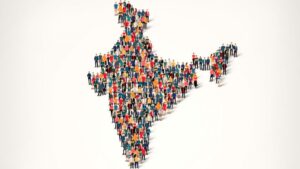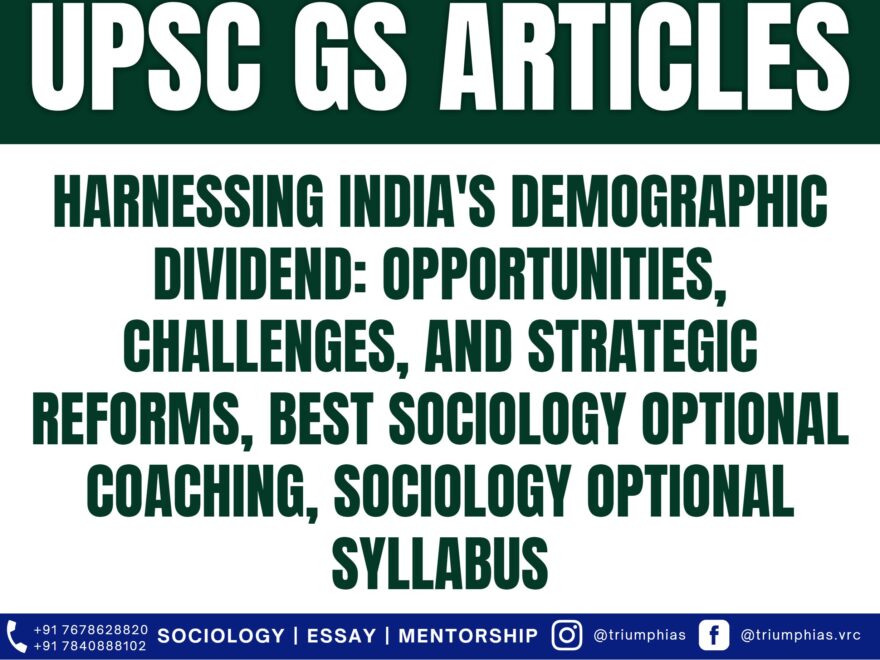India’s Demographic Dividend
AN OPPORTUNITY
(Relevant for General Studies Paper Prelims/Mains)

India, as one of the most populous nations globally, stands out as the youngest among them, with an average age of 29 years. Currently, India is experiencing a significant growth in its working-age population due to its large populace. However, projections indicate that by 2075, India’s old-age dependency ratio will reach 37 percent. This aligns with the global trend of population ageing and declining fertility rates.
This demographic situation presents India with a distinctive opportunity to harness the advantages of its favorable demographic composition, leading to potential economic growth and social advancement. Nonetheless, to fully realize this potential, India must confront certain critical challenges and undertake strategic reforms across various sectors. By doing so, the country can navigate its way towards a prosperous future.
Opportunities for India’s Demographic Dividend
- A substantial and youthful working-age populace has the potential to bolster the supply of labor, productivity, savings, and investment within the economy, thereby driving higher GDP growth and per capita income.
- The presence of a skilled workforce can enhance India’s competitiveness on the global stage, particularly in labor-intensive sectors like manufacturing, services, and agriculture.
- India can also reap the advantages of increased demand for its exports in the aging markets of developed nations.
- Moreover, this demographic advantage can contribute to social development by promoting improvements in healthcare, education, gender equality, and social cohesion.
- An empowered population is more likely to actively engage in democratic processes and civic participation, fostering a vibrant democracy.
- Furthermore, a population rich in creativity can serve as a catalyst for innovation and entrepreneurship across diverse domains, including science, technology, arts, and culture.
Key Challenges to Reap Demographic Dividend
- In the absence of appropriate policies, the expansion of the working-age population could result in a surge in unemployment, giving rise to economic and social risks.
- India is witnessing a phenomenon of jobless growth, where the current working-age population is unable to find employment opportunities.
- The decline in Female Labor Force Participation (FLFP) in India can be attributed to socio-cultural factors and increasing family incomes.
- Numerous qualified women opt out of the workforce due to various reasons, including the unavailability of suitable jobs in their locality, particularly in rural areas, as well as family responsibilities and marriage commitments.
- Given the emergence of new fields and opportunities, skilling and reskilling have become crucial in the present era.
- India may struggle to seize the opportunities presented due to its limited human capital base and a workforce that lacks adequate skills.
- According to ASSOCHAM, only a small percentage (20-30 percent) of engineers are able to find employment that aligns with their skill sets. This highlights the significant challenge posed by a low human capital base and the scarcity of skilled labor.
Ways for India to Improve its Demographic Dividend
- India possesses an expansive workforce of approximately 500 million individuals, and this number is projected to increase in the coming years.
- However, a significant portion of this workforce lacks proper skills or has insufficient skill levels, resulting in low productivity and limited employability within the evolving market conditions.
- To address this issue, India must strive to elevate its labor force participation rate (LFPR), which currently stands at around 50 percent, by creating more job prospects for the annually entering youth population.
- This necessitates a transition from the low-productivity agricultural sector to the higher-productivity manufacturing and services sectors, as these sectors can absorb more workers and generate increased income.
- Furthermore, India should enhance the quality and pertinence of its skill development programs, which aim to train and certify millions of workers across various industries.
- These programs ought to be aligned with industry demands, global standards, and emerging technologies. Additionally, they should offer lifelong learning opportunities to ensure continuous skill enhancement for workers.
To master these intricacies and fare well in the Sociology Optional Syllabus, aspiring sociologists might benefit from guidance by the Best Sociology Optional Teacher and participation in the Best Sociology Optional Coaching. These avenues provide comprehensive assistance, ensuring a solid understanding of sociology’s diverse methodologies and techniques.
India, Demographic Dividend, Working-age population, Economic Growth, Social Development, Unemployment, Jobless growth, Female Labor Force, Skill Development, Human Capital, Labor Force Participation Rate, Agriculture, Manufacturing, Services Sector, Innovation, Entrepreneurship, Education, Healthcare, Gender Equality, Best Sociology Optional Teacher, Best Sociology Optional Coaching, Sociology Optional Syllabus.
Follow us :
🔎 https://www.instagram.com/triumphias
🔎https://www.youtube.com/c/TriumphIAS
https://t.me/VikashRanjanSociology
Find More Blogs
|
Scope of the subject and comparison with other social sciences |
|||
|
|
|
|
Modernity and social changes in Europe |

